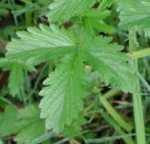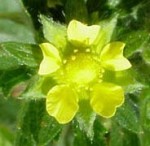 Rough cinquefoil, also called Norwegian cinquefoil, is an annual, biennial, or short-lived perennial native to Europe and Asia but is found in the eastern half of the United States and the northwestern states. It is an adaptable plant and grows in slightly moist to dry, fertile to infertile soils with sun to part sun. Rough cinquefoil is common along roadsides and in meadows, fields and pastures.
Rough cinquefoil, also called Norwegian cinquefoil, is an annual, biennial, or short-lived perennial native to Europe and Asia but is found in the eastern half of the United States and the northwestern states. It is an adaptable plant and grows in slightly moist to dry, fertile to infertile soils with sun to part sun. Rough cinquefoil is common along roadsides and in meadows, fields and pastures.

 Description: The plant shows itself in spring as a rosette of basal leaves about 6” across. Each leaf is borne on a long hairy petiole and consists of three oval hairy leaflets 2” x 1” in size and coarsely toothed. One to several, hairy, branched stems grow 2-3″ tall from each rosette. They are green and erect at first but gradually sprawl, become woody, and turn reddish purple with age. The leaves on the lower to middle stem are alternate and similar to those of the rosette although smaller and on shorter petioles. Leaves on the upper stem
Description: The plant shows itself in spring as a rosette of basal leaves about 6” across. Each leaf is borne on a long hairy petiole and consists of three oval hairy leaflets 2” x 1” in size and coarsely toothed. One to several, hairy, branched stems grow 2-3″ tall from each rosette. They are green and erect at first but gradually sprawl, become woody, and turn reddish purple with age. The leaves on the lower to middle stem are alternate and similar to those of the rosette although smaller and on shorter petioles. Leaves on the upper stem  tend to be smaller, simple, and lack petioles. The 5-petaled yellow flowers are 1/3″ -1/2” across and are borne in clusters at the tip of the stems over most of the summer. The sepals are distinctly longer than the petals. Tiny brown seeds 1/25” long are produced and dispersed by the wind. The root system is a shallow, branched taproot. Rough cinquefoil can be distinguished from other similar plants by the combination of hairy stems, three part leaves, and yellow flowers with sepals longer than petals.
tend to be smaller, simple, and lack petioles. The 5-petaled yellow flowers are 1/3″ -1/2” across and are borne in clusters at the tip of the stems over most of the summer. The sepals are distinctly longer than the petals. Tiny brown seeds 1/25” long are produced and dispersed by the wind. The root system is a shallow, branched taproot. Rough cinquefoil can be distinguished from other similar plants by the combination of hairy stems, three part leaves, and yellow flowers with sepals longer than petals.

 Control: Because seed is the only method of reproduction, eliminating the flowers before they set seed is essential. This can be done by hand pulling, hoeing, or mowing although mowing may result at first in more branches and a larger root system. Cultivation of the ground for 2-3 seasons is also effective.
Control: Because seed is the only method of reproduction, eliminating the flowers before they set seed is essential. This can be done by hand pulling, hoeing, or mowing although mowing may result at first in more branches and a larger root system. Cultivation of the ground for 2-3 seasons is also effective.